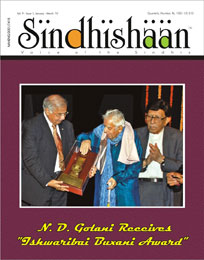WRITING AND READING SINDHI THROUGH
ROMAN SCRIPT
By Raj Daswani
Recently few Sindhi scholars and non-scholars met in Ahmedabad to discuss the possibility of adopting Roman Script for Sindhi writing and reading. Some individuals and organizations poke their dirty nose in this affair. No other comments.
When a child suffers from fever, doctor prescribes quinine. Quinine is supposed to be most bitter in taste. The remedy for that is sweet syrup mixed with quinine. Today our kids are scared of studying Sindhi language because of its unfamiliar Sindhi script, which tastes like quinine. We have to dilute it with syrup of Roman script, the taste of which is familiar and likable by children who migrated from Sindh when they were in mother's lap. And those who were born in divided India, and scattered all over the Globe. They were cut off not only from their roots but from their kith and kin's too.
Struggling for survival, no one thought what they are losing day by day, their culture, their traditions, their literature, and their language.
Changing our Sindhi script to Roman script may prove to be the last effort to keep our language alive.
This will only be possible if we teach our children to speak and understand Sindhi. Without this it will not be possible to make our new generation read, write or understand our Sindhi language.
There happen to be several formats of Roman script, to mention a few, format by Sadhu Vaswani mission, by Hindvasi, by Mr. Jairam Rupani, by Mr. Sujan Rawtani and others.
Fortunately I have experience of my personal life; I used to correspond with my father in Roman script. He did not know Sindhi script, only Roman and Hattaee. I knew Roman but not Hattaee, which I started learning and till now I remember few letters. Our method proved to be successful. He used to read my letters and I could read his.
The same method is used by me in my latest book Hemu Kalani which is going to be released very soon. I had given few pages to some youth who understand Sindhi but cannot read or write. This experiment proved to be very successful in London; ten out of ten could read correctly. (Of course at a slow speed.)
Same method is used in film industry. Since so many years on an average 350 films are made in India every year and the titles of the films are written in the Roman script. This is based on write as you pronounce.
Dialogues in some of the films and TV serials are subtitled in Roman script; these too are on the same basis WRITE AS YOU PRONOUNCE. This method is familiar to our non-Sindhi speaking young generation. Even our writers nowadays write the titles of their books on the edge of the book in Roman script.
Shri Satish Rohra who is an acclaimed and qualified linguist, during his visit in London, said we can adopt Roman script for Sindhi language as long as we maintain consistency in using the letters. Shri Kirat Babani who is a well known Sindhi writer also agreed with my method during discussions with him. WRITE AS YOU PRONOUNCE.
To put signs like (-) ( _ ) ( . ) (^) above or below the letters will confuse and deter our new readers.
OH! OUR WELL WISHER LINGUISTS TO SAVE OUR LANGUAGE PLEASE MAKE IT SIMPLE AND PRACTICAL. I WOULD SUGGEST ARRANGING WORK SHOPS IN DIFFERENT PARTS OF INDIA AND ABROAD, UNTIL YOU COME UP WITH SOME RESULTS, BEFORE YOU INFLUENCE YOUNGTERS WITH UNTRIED IDEAS OF YOURS.


